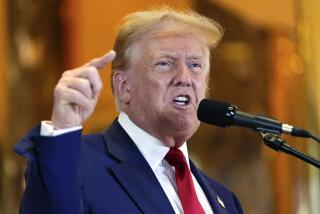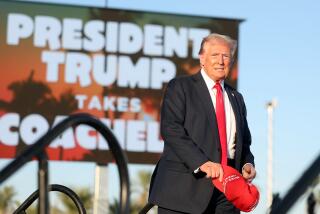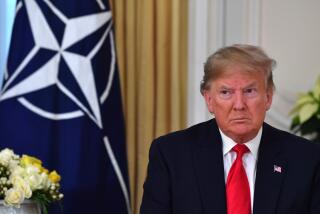Why American voters were primed for a president who talks like Trump
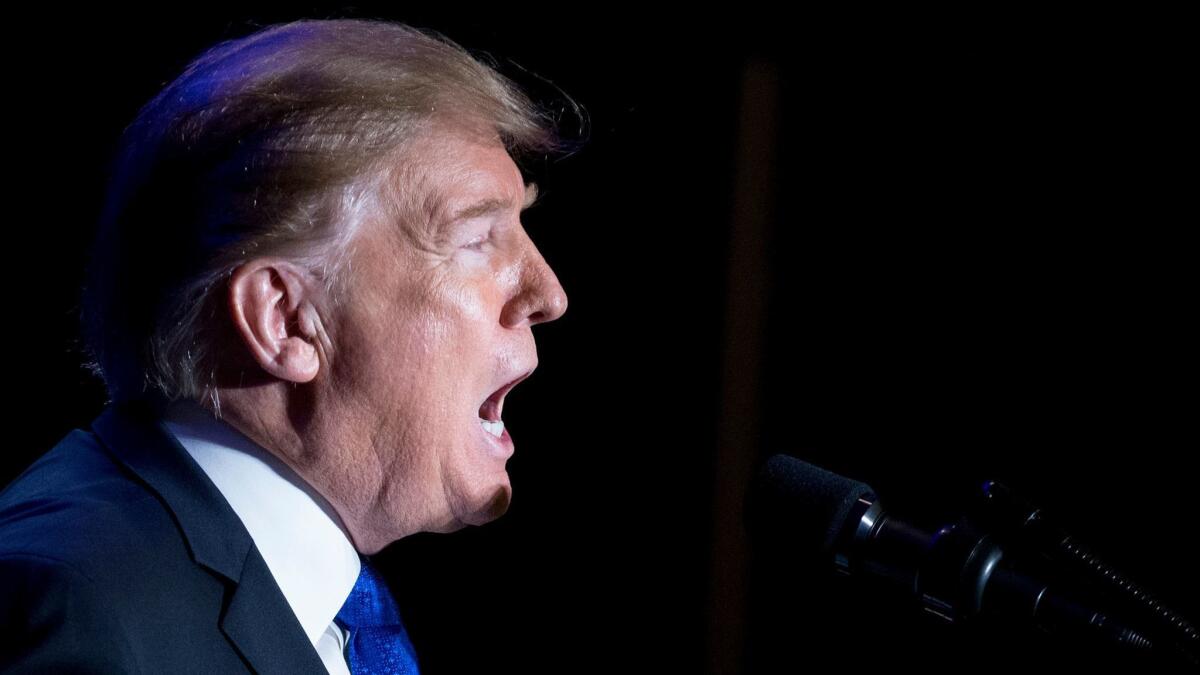
When in the grips of oratorical passion, President Obama liked to paraphrase the Rev. Martin Luther King Jr. about the “long arc of history” bending toward justice.
But when it comes to the oratory of American politicians, history’s long arc is bending away from such lofty rhetorical flourishes. New research finds that the punch-and-jab style of President Trump’s public speech — pugnaciously declarative, larded with personal pronouns, and light on the kinds of phrases that soften a claim or elevate an idea — appears to be just where presidential discourse is headed.
The sweeping linguistic analysis of American leaders suggests far from being an aberration, Trump’s style of communication — called “intuitive” because it closely resembles ordinary conversational speech — is the most recent exemplar of a trend that goes back to the early 1900s.
For more than a century, presidents’ public speech patterns have been evolving toward more forceful assertions of personal leadership — a measure the researchers call “clout.” At the same time, the complexity of presidential speech has been trending downward.
“Voters may increasingly be drawn to leaders who can make difficult, complex problems easier to understand with intuitive, confident answers,” the psychology researchers wrote this week in the Proceedings of the National Academy of Sciences.
The findings “confirm that President Trump and leaders like him did not emerge out of nowhere,” they added. Rather, when it comes to using language that conveys personal power and complex thought, Trump and similarly plain-spoken politicians “are the most recent incarnation of long-term political trends.”
Kayla N. Jordan, a graduate student specializing in language and political psychology at the University of Texas, and her coauthors took a rigorous look at American presidents’speech since 1780. They also explored the utterances of lawmakers in the House and Senate.
The effort subjected billions of words — delivered on stumps, at rallies and behind lecterns — to the scrutiny of computer software that deconstructs grammar and counts and classifies words by their function in a sentence.
Such “automated text analysis” can reveal the distinctive patterns of an individual’s speech. Using similar methods in 2015, University of Texas psychologist James W. Pennebaker dissected a play of disputed authorship and judged it to have been written by William Shakespeare. (Pennebaker worked on the new study as well.)
Now psychologists are demonstrating that such text analysis can offer clues to a speaker’s thinking style — whether she is inclined to lead or follow others, whether he tends to see the world in simple or complex terms, and whether her views are shaped more by abstract ideas or by personal experiences.
“It’s a fascinating idea: that grammar and speech reflects cognitive style,” said University of Chicago psychologist Thomas Talhelm, whose own research explores the link between language and cultural and individual differences.
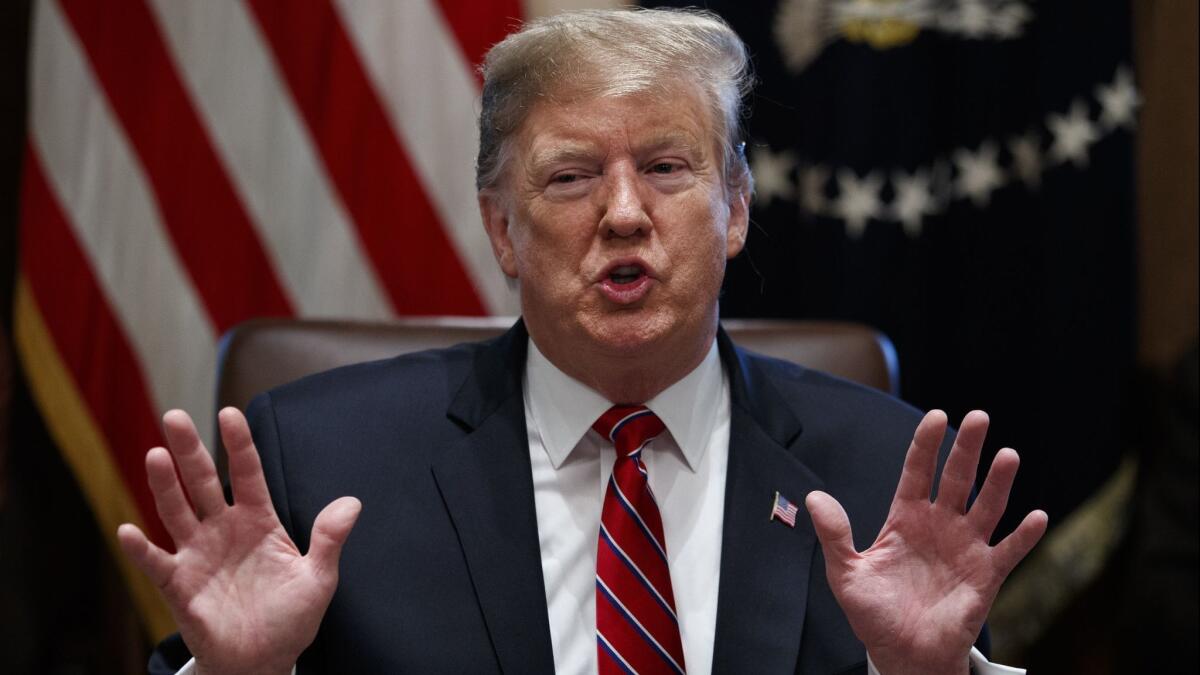
The oratory of British, Canadian, Australian and European Union leader also got the textual-analysis treatment. To compare political speech to other modes of communication, the researchers used software to dissect the language of 5,418 books, 11,921 movies, 2,141,668 articles published in the New York Times, and daily transcripts from the cable news channel CNN.
Few stark contrasts emerged among the world’s English-speaking politicians. But one trend became evident over time: American presidents’ style of speech was changing.
From the early days of the Republic until around the outbreak of World War I, presidents spoke to the nation in a style that reflected a bent toward “analytic thinking,” the researchers found. A linguistic measure of a president’s power and assertiveness — clout — bumped along at a relatively low level.
Earlier presidents favored complex sentences that were more difficult for a casual listener to grasp. They used more prepositions — words like “in,” “above” and “whether” — which tend to introduce context or stitch separate ideas into a single sentence. They went a little lighter on articles of speech like adverbs, the kinds of words that project power and action. And they used a lot of articles — “the,” “a” and “an” — which usually precede nouns.
To understand why the copious use of articles and their fellow travelers, nouns, signifies abstract thinking, Jordan offers this illustration: Contrast a sentence such as “the people voted” with “the people engaged in voting behavior.” A more intuitive speaker would simply use the verb “voted.” An abstract thinker would elevate that act to an abstract behavior — voting — and use two nouns instead of one.
Finally, presidents of yore frequently used collective pronouns like “we” and “us,” and they rarely used personal pronouns (“I,” “me” and “my”) that would invite a more direct and conversational connection to a listener. (For more on these distinctions, see Pennebaker’s book The Secret Life of Pronouns: What Our Words Say About Us.)
The language of pre-1900 presidents projected less authority as well, the authors said. These leaders used more negations — “we won’t do this” as opposed to “we’ll do that” — a form of speech that conveys less personal confidence. And they made greater use of grammatical constructions that hedged a bold assertion (words like “actually,” “although,” “despite” and “otherwise”).
Clout and “analytic” speech don’t necessarily oppose each other, and politicians rely on both to communicate. But the mix changes from person to person. Speech that is more intuitive may make a direct connection with an audience, something modern voters seem to value, Jordan said. And a leader’s use of personal pronouns may promote that connection too. But those highly accessible turns of phrase don’t position the speaker above his audience — they don’t convey clout. And they don’t always sound very smart, she said.
But historical patterns started to change in the early 1900s. In their inaugural speeches, their State of the Union addresses, their public papers and their political debates, presidents began to address the nation in increasingly simple, straightforward sentences that a casual listener could more readily follow.
Around the time of Woodrow Wilson’s presidency (1913 to 1921), speech that reflected high levels of analytical thought began to decline, and speech that conveyed a speaker’s clout began to rise. The lines were jagged — not every president fit the model perfectly — but the trend lines were clear: as the century progressed and the current millennium began, American presidents spoke ever more plainly, and in more confident and personal terms.
That trend almost certainly doesn’t reflect the emergence of a simpler world, the authors acknowledged. Whether it reflects the rise of populism remains to be tested, they added.
What is apparent is that changes in presidential speaking styles track with rapid changes in the means of communication.
“The style used by early presidents who communicated through writing in newspapers and in-person speeches to small audiences likely was increasingly ineffective in the face of mass communication technologies, such as radio, television, and the internet today,” the authors wrote.
By the time Trump came along, his high-clout, low-analysis mode of speech was not a stark departure from his immediate predecessors, the researchers found. And that includes Obama.
The only case in which Trump diverged significantly was in the candidate debates, where he was much less analytic and spoke with much more clout than what would have been predicted by the arc of presidential oratory. Since debates aren’t scripted, they probably offer the best evidence for Trump’s “natural inclination to a less analytic thinking style,” the authors wrote.
“Our analysis suggests that Donald Trump — while somewhat more extreme than would have been predicted — conforms to the direction of previous trends and is not an outlier from those trends, statistically speaking,” the team wrote.
To the extent that Jordan, Pennebaker and their colleagues infer leaders’ individual thinking styles from their public speeches, they “may make the case a bit too strongly,” said Talhelm, who was not involved with the new study. But they certainly appear to have captured important shifts in the ways that leaders communicate with the public, including the decline of elitism, he said.
Oh, and that metaphor that conjures the abstract notion of “justice” and invites listeners to visualize its trajectory over time? If you ran that through a textual analysis, it would seem more typical of the speech that prevailed in the mid-19th century, right?
Indeed, it is: the adage that Obama was so fond of paraphrasing — “The arc of the moral universe is long, but it bends toward justice” — was first penned in 1853 by the abolitionist and Unitarian minister Theodore Parker. The quotation reappeared in a number of forms throughout the 19th and 20th centuries, and was reprised by King in a sermon delivered in 1964.
MORE IN SCIENCE
